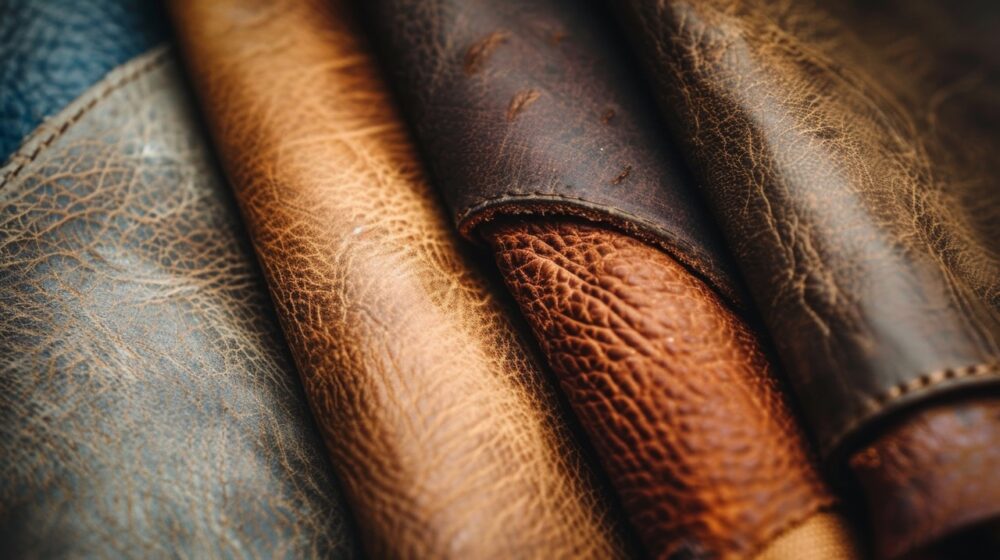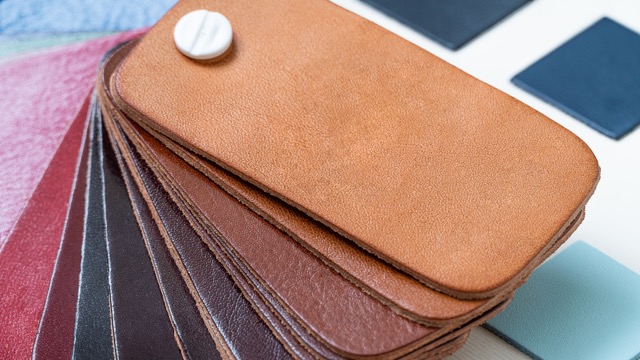Leather has a special quality—from the tough, worn look of a jacket to the sleek, fancy feel of a nice briefcase. There’s just something captivating about this material. Given the craftsmanship that goes into leather making, there’s no surprise that this practice has already been around for more than 7,000 years.
There are various leather types, and understanding the differences can help you choose the right leather goods for your needs. This article will take a closer look at them. You’ll explore the special features, backstories, and practical details to guide you to the perfect leather item. So, read on.

Full-grain leather
Full-grain leather is considered the best kind of leather. This is the top choice for leather fans and experts. But what makes it so special?
Firstly, the material or animal used. Most manufacturers use cattle hides to create leather. In fact, 65% of all leather products are made from hides.
Another reason why full-grain leather is on top is because it doesn’t get processed much. The outer layer, called the ‘grain,’ is left alone. This gives full-grain leather a tough, natural look that gets even better as it gets older.
As you use and care for full-grain leather items, they develop a one-of-a-kind look that tells the story of where they’ve been. This natural ageing process is part of what makes full-grain leather so appealing—every piece is truly unique.
Manufacturers who use full-grain leather live by its beauty. For example, Vonbaer.com says that full-grain leather is the best type of leather for bags, as it’s both durable and aged well with a beautiful patina.
Besides its distinctive appearance, full-grain leather is also incredibly durable. The dense, tightly woven fibres of the grain layer make this leather super strong and resistant to wear and tear.
Whether you’re talking about a stylish wallet, a pair of long-lasting boots, or a sturdy briefcase to complete luxurious office wear, full-grain leather is built to last. It can handle the demands of everyday life and just get better with time.
Top-grain leather
You might be wondering, ‘If full-grain leather is the best, why wouldn’t every manufacturer just choose that for everything?’
The main reason is the price. The detailed manufacturing process and use of the whole hide make full-grain leather more expensive. That higher cost can be a problem, especially for people on a tighter budget.
That’s where top-grain leather comes in. It’s a step down from full-grain, but it’s still high-quality. Top-grain leather goes through a bit more processing—the outer layer, called the grain, gets sanded or buffed to smooth out any imperfections. This gives the leather a smoother, more uniform look. But it also means the leather loses some of its natural character and durability.
Top-grain leather is still strong and attractive. It’s a good middle ground for people who want the look and feel of quality leather without the premium price. Top-grain leather goods may not develop the same depth of character over time, but they still offer a stylish and long-lasting option.

Genuine leather
For an even more budget-friendly option, there’s genuine or cowhide leather. This comes from the inner layers of the hide after the tougher outer layer has been removed. It’s a more affordable choice, but it’s still a real leather product. However, it’s important to know that genuine leather is different from ‘bonded’ or ‘faux’ leather, which is made from leather scraps and synthetic materials.
Genuine leather, while not as high-end as other leathers, is still a natural and authentic material preferred by many. In fact, it contributes 53.6% to the overall leather market size, making it the largest contributor in the industry.
Suede
The last leather type to consider is suede. This soft, velvety material comes from the underside of the hide rather than the outer layer. Suede has a unique feel that appeals to many, and it’s often used for clothing, accessories, and home furnishings.
Although it may not be as durable as other leathers, suede can still be a practical choice for the right uses. Its luxurious feel and appearance make it popular for items like gloves, jackets, and throw pillows. Just keep in mind that suede requires a bit more care to keep it looking its best.
Choosing the right leather for your needs
Now that you know more about the different leather options, it’s time to learn how to pick the right one for you.
- Determining your needs
First, think about how the leather will be used. If you need something super rugged and durable that can withstand heavy wear and tear over the long haul, full-grain leather is probably your best bet. It develops a gorgeous natural patina over time and is built to last.
On the flip side, if you’re looking for a more budget-friendly option without sacrificing too much on quality, top-grain leather could strike a nice balance.
- Considering the aesthetics
Of course, aesthetics is also a major consideration. The grainy, rustic look of full-grain has a certain undeniable charm, while top-grain offers a smoother, more consistent appearance. And if you’re after that plush, velvety feel, suede is hard to beat in terms of sheer luxurious texture.
- Maintenance requirements
Finally, factor in how much maintenance you’re willing to commit to. Full-grain and top-grain leathers require a bit more TLC to protect against stains, scratches, and other damage. Meanwhile, suede is especially delicate and needs ultra-gentle care to preserve its soft hand.
By weighing these factors, you can easily choose the leather type that’s the perfect fit for your needs. Whether it’s durable full-grain, affordable top-grain, or luxurious suede, there’s a leather out there that will work just right for you.
In closing
At the end of the day, the ‘best’ leather really comes down to what works best for you. Knowing the unique traits of each leather type can help guide you to the perfect match. So, whether you’re looking to buy leather goods for yourself or as a luxury gift to a loved one, the right choice is the one that fits your needs.
Take the time to consider what matters most and let that be your North Star as you navigate the world of fine leathers. With the right pick, you can invest in goods that not only look amazing but stand the test of time.



















